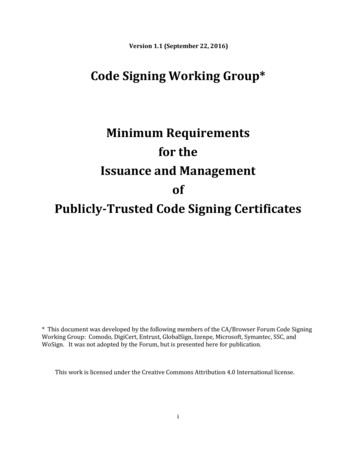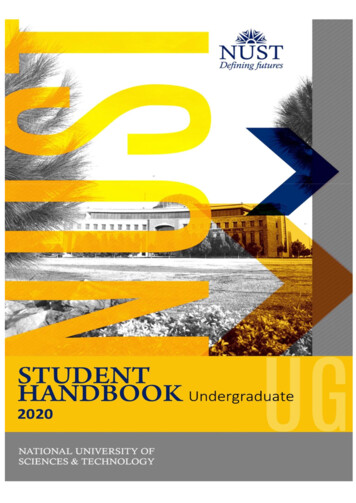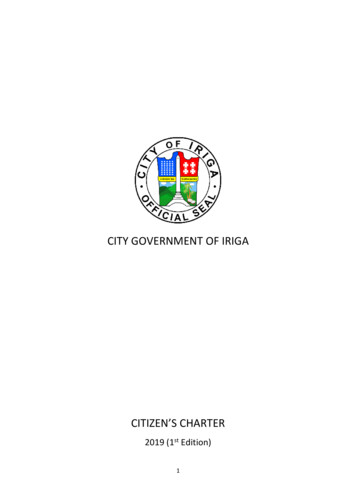
Transcription
Version 1.1 (September 22, 2016)Code Signing Working Group*Minimum Requirementsfor theIssuance and ManagementofPublicly-Trusted Code Signing Certificates* This document was developed by the following members of the CA/Browser Forum Code SigningWorking Group: Comodo, DigiCert, Entrust, GlobalSign, Izenpe, Microsoft, Symantec, SSC, andWoSign. It was not adopted by the Forum, but is presented here for publication.This work is licensed under the Creative Commons Attribution 4.0 International license.i
TABLE OF CONTENTSContents1.2.3.4.5.6.7.Scope . 5Purpose . 5References . 5Definitions . 5Abbreviations and Acronyms . 8Conventions . 8Certificate Warranties and Representations . 87.1 Certificate Beneficiaries . 87.2 Certificate Warranties. 87.3 Applicant Warranty . 98. Community and Applicability . 98.1 Compliance . 98.2 Certificate Policies . 108.2.1Implementation . 108.2.2Disclosure . 108.3 Commitment to Comply . 108.4 Trust model . 119. Certificate Content and Profile . 119.1 Issuer Information . 119.2 Subject Information . 119.2.1Subject Alternative Name Extension . 119.2.2Subject Common Name Field. 119.2.3Subject Domain Component Field . 119.2.4Subject Distinguished Name Fields. 119.2.5Reserved . 139.2.6Subject Organizational Unit Field . 139.2.7Reserved . 139.2.8Other Subject Attributes. 139.3 Certificate Policy Identification . 139.3.1Certificate Policy Identifiers . 139.3.2Root CA Requirements . 139.3.3Subordinate CA Certificates . 139.3.4Subscriber Certificates . 149.4 Maximum Validity Period . 149.5 Subscriber Public Key . 149.6 Certificate Serial Number . 149.7 Reserved . 159.8 Reserved . 1510.Certificate Request . 1510.1Documentation Requirements . 1510.2Certificate Request . 1510.2.1General . 15ii
10.2.2Request and Certification . 1510.2.3Information Requirements . 1510.2.4Subscriber Private Key . 1510.3Subscriber Agreement . 1610.3.1General . 1610.3.2Agreement Requirements . 1610.3.3Service Agreement Requirements for Signing Authorities. 1711.Verification Practices . 1811.1Verification of Organizational Applicants . 1811.1.1Organization Identity and Address. 1811.1.2DBA/Tradename . 1811.1.3Requester Authority . 1811.2Verification of Individual Applicants. 1811.2.1Individual Identity . 1811.2.2Authenticity of Identity . 1911.3Age of Certificate Data . 1911.4Denied List. 1911.5High Risk Certificate Requests . 1911.6Data Source Accuracy . 2011.7Processing High Risk Applications . 2011.8Due Diligence. 2012.Certificate Issuance by a Root CA . 2113.Certificate Revocation and Status Checking . 2113.1Revocation . 2113.1.1Revocation Request. 2113.1.2Certificate Problem Reporting . 2113.1.3Investigation . 2113.1.4Response. 2213.1.5Reasons for Revoking a Subscriber Certificate . 2213.1.6Reasons for Revoking a Subordinate CA Certificate . 2313.1.7Certificate Revocation Date . 2313.2Certificate Status Checking . 2314.Employees and Third Parties. 2514.1Trustworthiness and Competence . 2514.2Delegation of Functions to Registration Authorities and Subcontractors . 2514.2.1General . 2514.2.2Compliance Obligation . 2614.2.3Allocation of Liability . 2615.Data Records . 2616.Data Security and Private Key Protection . 2716.1Timestamp Authority Key Protection . 2716.2Signing Service Requirements . 2716.3Subscriber Private Key Protection . 2717.Audit . 2817.1Eligible Audit Schemes . 2817.2Audit Period . 2817.3Audit Report . 2817.4Pre-Issuance Readiness Audit . 2817.5Audit of Delegated Functions . 28iii
17.6Auditor Qualifications. 2917.7Key Generation Ceremony . 2918.Liability and Indemnification . 29Appendix A . 30Appendix B . 32Appendix C . 37Appendix D . 38iv
1.ScopeThe Minimum Requirements for the Issuance and Management of Publicly-Trusted Code SigningCertificates describe a subset of the requirements that a Certification Authority must meet to issuepublicly-trusted Code Signing Certificates. This document incorporates by reference both theBaseline Requirements for the Issuance and Management of Publicly-Trusted Certificates (“BaselineRequirements”) and the Network and Certificate System Security Requirements as established bythe CA/Browser Forum, copies of which are available on the CA/Browser Forum’s website atwww.cabforum.org.The scope of these Requirements includes all “Code Signing Certificates”, as defined below, andassociated Timestamp Authorities, and all Certification Authorities technically capable of issuingCode Signing Certificates, including any Root CA that is publicly trusted for code signing and allother CAs that might serve to complete the validation path to such Root CA. These Requirementsdo not address the issuance, use, maintenance, or revocation of Certificates by enterprises thatoperate their own Public Key Infrastructure for internal purposes only, where the Root CACertificate is not distributed by any Application Software Supplier (as defined in the BaselineRequirements).2.PurposeThe primary goal of these Requirements is to enable trusted signing of code intended for publicdistribution, while addressing user concerns about the trustworthiness of signed objects andaccurately identifying the software publisher. The Requirements also serve to inform users aboutthe purpose of signed code, help users make informed decisions when relying on Certificates, helpestablish the legitimacy of signed code, help maintain the trustworthiness of software Platforms,help users make informed software choices, and limit the spread of malware. Code signingcertificates do not identify a particular software object, identifying only the distributor of software.3.ReferencesAs specified in the Baseline Requirements. Cross-references to Sections of the BaselineRequirements are notated with the letters “BR”, as in “BR Section 1.2.”This document may also mention or refer to the CA/Browser Forum’s Extended ValidationGuidelines for the Issuance and Management of Extended Validation Certificates (“EV SSLGuidelines”) and the Guidelines for the Issuance and Management of Extended Validation CodeSigning Certificates (“EV Code Signing Guidelines”), also available on the CA/Browser Forum’swebsite at www.cabforum.org.4.DefinitionsCapitalized Terms are as defined in the Baseline Requirements except where defined below:Anti-Malware Organization: An entity that maintains information about Suspect Code and/ordevelops software used to prevent, detect, or remove malware.5
Application Software Supplier: A supplier of software or other relying-party application softwarethat displays or uses Code Signing Certificates, incorporates Root Certificates, and adopts theseRequirements as all or part of its requirements for participation in a root store program.Certification Authority: An organization subject to these Requirements that is responsible for aCode Signing Certificate and, under these Requirements, oversees the creation, issuance,revocation, and management of Code Signing Certificates. Where the CA is also the Root CA,references to the CA are synonymous with Root CA.Certificate Beneficiaries: As defined in section 7.1.1.Certificate Requester: A natural person who is the Applicant, employed by the Applicant, anauthorized agent who has express authority to represent the Applicant, or the employee or agent ofa third party (such as software publisher) who completes and submits a Certificate Request onbehalf of the Applicant.Code Signature: A Signature logically associated with a signed Object.Code Signing Certificate: A digital certificate issued by a CA that contains a code Signing EKU,contains the anyExtendedKeyUsage EKU, or omits the EKU extension and is trusted in anApplication Software Provider’s root store to sign software objects. [NOTE: Appendix B, subsection(3) of Appendix B requires the presence of the codeSigning EKU and prohibits use of theanyExtendedKeyUsage EKU.]Declaration of Identity: A written document that consists of the following:1. the identity of the person performing the verification,2. a signature of the Applicant,3. a unique identifying number from an identification document of the Applicant,4. the date of the verification, and5. a signature of the Verifying Person.Effective Date: The date this document is adopted as a root store requirement by an ApplicationSoftware Supplier.High Risk Region of Concern (HRRC): As set forth in Appendix D, a geographic location where thedetected number of Code Signing Certificates associated with signed Suspect Code exceeds 5% ofthe total number of detected Code Signing Certificates originating or associated with the samegeographic area.Issuer: The CA providing a Code Signing Certificate to the Subscriber.Individual Applicant: An Applicant who is a natural person and requests a Certificate that will listthe Applicant’s legal name as the Certificate’s Subject.6
Lifetime Signing OID: An optional extended key usage OID (1.3.6.1.4.1.311.10.3.13) used byMicrosoft Authenticode to limit the lifetime of the code signature to the expiration of the codesigning certificate.Object: A contiguous set of bits that has been or can be digitally signed with a Private Key thatcorresponds to a Code Signing Certificate; also referred to herein as “Code”.Organizational Applicant: An Applicant that requests a Certificate with a name in the Subject fieldthat is for an organization and not the name of an individual. Organizational Applicants includeprivate and public corporations, LLCs, partnerships, government entities, non-profit organizations,trade associations, and other legal entities.Platform: The computing environment in which an Application Software Supplier uses CodeSigning Certificates, incorporates Root Certificates, and adopts these Requirements.QGIS: As defined in the EV SSL Guidelines.QIIS: As defined in the EV SSL Guidelines.Registration Identifier: The unique code assigned to an Applicant by the Incorporating orRegistration Agency in such entity’s Jurisdiction of Incorporation or Registration.Requirements: This document, the Baseline Requirements, and the Network and CertificateSystem Security Requirements.Signature: An encrypted electronic data file which is attached to or logically associated with otherelectronic data and which (i) identifies and is uniquely linked to the signatory of the electronic data,(ii) is created using means that the signatory can maintain under its sole control, and (iii) is linkedin a way so as to make any subsequent changes that have been made to the electronic datadetectable.Signing Service: An organization that signs an Object on behalf of a Subscriber using a Private Keyassociated with a Code Signing Certificate.Subscriber: The Subject of a Code Signing Certificate. A Subscriber is the entity responsible fordistributing the software but does not necessarily hold the copyright to any software.Suspect Code: Code that contains malicious functionality or serious vulnerabilities, includingspyware, malware and other code that installs without the user's consent and/or resists its ownremoval, and code that can be exploited in ways not intended by its designers to compromise thetrustworthiness of the Platforms on which it executes.Takeover Attack: An attack where a Signing Service or Private Key associated with a Code SigningCertificate has been compromised by means of fraud, theft, intentional malicious act of the Subject’sagent, or other illegal conduct.Timestamp Authority: A service operated by the CA or a delegated third party for its own codesigning certificate users that timestamps data using a certificate chained to a public root, therebyasserting that the data (or the data from which the data were derived via a secure hashingalgorithm) existed at the specified time. If the Timestamp Authority is delegated to a third party, theCA is responsible that the delegated third party complies with these guidelines.7
Timestamp Certificate: A certificate issued to a Timestamp Authority to use to timestamp data.Trusted Platform Module: A microcontroller that stores keys, passwords and digital certificates,usually affixed to the motherboard of a computer, which due to its physical nature makes theinformation stored there more secure against external software attack or physical theft.Verifying Person: A notary, attorney, Latin notary, accountant, individual designated by agovernment agency as authorized to verify identities, or agent of the CA, who attests to the identityof an individual.5.Abbreviations and AcronymsAs specified in the Baseline Requirements.6.ConventionsTerms not otherwise defined in these Requirements are as defined in the CA’s applicableagreements, user manuals, Certificate Policies, and Certification Practice Statements.The key words "MUST”, “MUST NOT”, "REQUIRED", "SHALL", "SHALL NOT", "SHOULD", "SHOULDNOT", "RECOMMENDED", "MAY", and "OPTIONAL" in these Requirements are used in accordancewith RFC 2119.7.Certificate Warranties and Representations7.1Certificate BeneficiariesCertificate Beneficiaries means any one of the following:1. All Application Software Suppliers with whom the Issuer or its Root CA has entered into acontract for distribution of its Root Certificate in software distributed by such ApplicationSoftware Suppliers, or2. All Relying Parties who reasonably rely on such a Certificate while a Signature associatedwith the Certificate is valid.7.2Certificate Warranties1. Compliance. The Issuer and any Signing Service each represents that it has complied withthese Requirements and the applicable Certificate Policy and Certification PracticeStatement in issuing each Code Signing Certificate and operating its PKI or Signing Service.2. Identity of Subscriber: At the time of issuance, the Issuer or Signing Service representsthat it (i) operated a procedure for verifying the identity of the Subscriber that at leastmeets the requirements in Section 11 of this document, (ii) followed the procedure whenissuing or managing the Certificate, and (iii) accurately described the same procedure in theIssuer’s Certificate Policy or Certification Practice Statement.8
3. Authorization for Certificate: At the time of issuance, the Issuer represents that it (i)operated a procedure for verifying that the Applicant authorized the issuance of theCertificate, (ii) followed the procedure, and (iii) accurately described the same procedure inthe Issuer’s Certificate Policy or Certification Practice Statement.4. Accuracy of Information: At the time of issuance, the Issuer represents that it (i) operateda procedure for verifying that all of the information contained in the Certificate (with theexception of the subject:organizationalUnitName attribute) was true and accurate, (ii)followed the procedure, and (iii) accurately described the same procedure in the CA’sCertificate Policy or Certification Practice Statement.5. Key Protection: The Issuer represents that it provided the Subscriber at the time ofissuance with documentation on how to securely store and prevent the misuse of PrivateKeys associated with Code Signing Certificates, or in the case of a Signing Service, securelystored and prevented the misuse of Private Keys associated with Code Signing Certificates;6. Subscriber Agreement: The Issuer and Signing Service represent that the Issuer orSigning Service entered into a legally valid and enforceable Subscriber Agreement with theApplicant that satisfies these Requirements.7. Status: The CA represents that it will maintain a 24 x 7 online-accessible Repository withcurrent information regarding the status of Certificates as valid or revoked for the periodrequired by these Requirements.8. Revocation: The CA represents that it will revoke a Certificate upon the occurrence of arevocation event specified in these Requirements.7.3Applicant WarrantyThe Issuer or Signing Service MUST require, as part of the Subscriber Agreement, that the Applicantmake the commitments and warranties set forth in Section 10.3.2 and/or Section 10.3.3 of thisdocument, as applicable, for the benefit of the Issuer and the Certificate Beneficiaries.8.Community and Applicability8.1ComplianceThe CA and/or all Signing Services MUST, at all times:1. Comply with all laws applicable to its business and the Certificates it issues in eachjurisdiction where it operates,2. Comply with these Requirements,3. Comply with the audit requirements set forth in Section 17 of this document, and4. If a CA, be licensed as a CA in each jurisdiction where it operates, if licensing is required bythe law of such jurisdiction for the issuance of Certificates.9
If a court or government body with jurisdiction over the activities covered by these Requirementsdetermines that the performance of any mandatory requirement is illegal, then such requirement isconsidered reformed to the minimum extent necessary to make the requirement valid and legal.This applies only to operations or certificate issuances that are subject to the laws of thatjurisdiction. The parties involved MUST notify the Application Software Suppliers of the facts,circumstances, and law(s) involved.8.2Certificate Policies8.2.1ImplementationThe CA and its Root CA MUST develop, implement, enforce, display prominently on its Web site, andperiodically update its policies and practices, including its Certificate Policy and/or CertificationPractice Statement that implement the most current version of these Requirements.With the exception of revocation checkin
Code Signing Certificate and, under these Requirements, oversees the creation, issuance, revocation, and management of Code Signing Certificates. Where the CA is also the Root CA, references to the CA are synonymous with Root CA. Certificate Beneficiaries: As defined in section 7.1.1.











